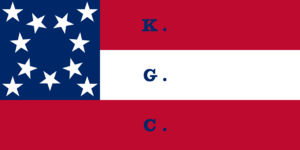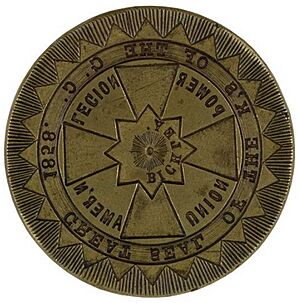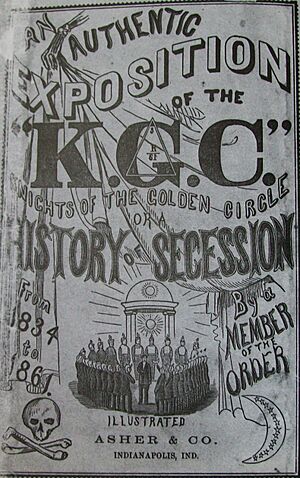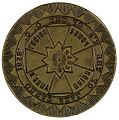Knights of the Golden Circle facts for kids

Flag of the Knights of the Golden Circle
|
|
| Abbreviation | KGC |
|---|---|
| Formation | July 4, 1854 |
| Dissolved | 1863 |
| Type | Paramilitary |
| Purpose |
|
| Headquarters | Cincinnati, Ohio, United States |
|
Official language
|
English |
| Leader | George W. L. Bickley |


The Knights of the Golden Circle (KGC) was a secret society formed in 1854. An American named George W. L. Bickley started it. Their main goal was to create a new country called the Golden Circle. In this new country, slavery would be legal.
This proposed country would have been centered in Havana, Cuba. It would include the Southern United States. It also planned to take over parts of Mexico, Central America, and northern South America. Many islands in the Caribbean, like Cuba and Haiti, were also part of the plan. This "golden circle" would be about 2,400 miles wide.
At first, the KGC wanted these new lands to join the United States. This would greatly increase the number of slave states. It would also boost the power of the Southern slave owners. But after the Dred Scott decision in 1857, things changed. This decision made many people against slavery. So, the Knights changed their plan. They decided the Southern United States should leave the Union. They would form their own country. Then, they would invade and add the Golden Circle area. This would make the South much more powerful. The new country's northern border would be near the Mason–Dixon line. It would include cities like Washington D.C., St. Louis, and Mexico City.
The KGC's idea came from earlier failed plans. These plans tried to take over Cuba, parts of Central America, and all of Mexico. In Cuba, many people wanted to be free from Spain. Mexico and Central America did not want to join the United States. As the movement to end slavery grew, the KGC wanted a separate group of slave states. They wanted Southern U.S. states to leave the Union. Then, they would join with new slave states from the "golden circle." Their main goal was to make the Southern slave-owning class so strong it could never be removed.
During the American Civil War, some Southern supporters in the Northern states were accused of being KGC members. These states included Ohio, Illinois, Indiana, and Iowa. Some, like Lambdin P. Milligan, were put in prison for their actions. The Knights of the Golden Circle was a secret group. However, its existence was actually well-known.
Contents
Why the KGC Started
European countries had started to reduce their use of slavery. But some places still relied on it. These included Spanish lands like Cuba and Puerto Rico. The country of Brazil also still used slavery. So did the Southern United States. Before the American Civil War, the debate over slavery was a major issue in the U.S. The number of enslaved people in the U.S. kept growing. This was even after the international slave trade was banned. Slavery was most common in the Deep South. There, large farms grew crops like cotton and sugar cane. But slavery was used for many types of work across the Southern states.
Early Days of the KGC
George W. L. Bickley was a doctor and adventurer. He lived in Cincinnati, Ohio. He started the KGC and formed its first local group there in 1854. Membership grew slowly at first. It reached its peak in 1860. The group's members were spread out. They were in places from New York to California and even Latin America. But the total number of members was never very large. Records from a KGC meeting in 1860 say the group began in Lexington, Kentucky. It started on July 4, 1854, with five men called together by George Bickley. Some KGC members in Northern states, like Illinois, were accused of working against the Union after the Civil War began in 1861.
Bickley had money problems. He left Cincinnati in the late 1850s. He traveled through the East and South. He promoted a plan to send an armed group to Mexico. The KGC's first goal was to create a force to settle northern Mexico and the West Indies. This would help expand areas that supported slavery. In August 1861, The New York Times said the KGC was like an earlier group. This group was called the Order of the Lone Star. It had tried to conquer Cuba and Nicaragua. It succeeded in Nicaragua in 1856 under William Walker. But then a group of nearby states drove them out. At that time, the KGC's main goal was to raise an army of 16,000 men. They wanted to conquer Mexico and make slavery legal there again. They also supported their highest-ranking members for public office.
Plans to Stop Lincoln
Several people in President James Buchanan's government were KGC members. These included Secretary of War John B. Floyd and Secretary of Treasury Howell Cobb. Vice President John C. Breckinridge was also a member. Floyd received orders from the KGC. They told him to "seize Navy-yards, Forts, etc." while KGC members were still in power. The plan was to stop Abraham Lincoln from reaching Washington. They wanted to capture him in Baltimore. Then they would take over Washington, D.C. They would make Breckinridge president instead of Lincoln. Floyd used his power as Secretary of War. He moved weapons and men to the South near the end of Buchanan's time as president. His plan was discovered. This led to more distrust of secret groups. It also increased distrust of Northern Democrats who opposed the war. This distrust came from a real plot to overthrow the government.
Robert Barnwell Rhett was called "the father of secession." A few days after Lincoln was elected, he said:
We will expand, as our growth and civilization shall demand—over Mexico—over the isles of the sea—over the far-off Southern tropics—until we shall establish a great Confederation of Republics—the greatest, freest and most useful the world has ever seen.
KGC During the Civil War
In the Southwest
In 1859, Elkanah Greer started KGC groups in East Texas and Louisiana. He later became a Confederate general. U.S. Senator Sam Houston was a Union supporter. But in 1858, he suggested a plan to the U.S. Senate. He wanted the U.S. to protect trade routes across Mexico. This plan supported a KGC goal. But it was not approved. By spring 1860, Elkanah Greer was a general in the KGC. He led 4,000 Military Knights in Texas. The Texas KGC supported President Buchanan's plan to protect U.S. trade routes in Mexico. This plan also failed.
When Abraham Lincoln was elected president, the Texas KGC changed its focus. They stopped planning to expand U.S. territory into Mexico. Instead, they focused on helping Southern states leave the Union. On February 15, 1861, Ben McCulloch was a U.S. Marshal. He was also a former Texas Ranger. He marched toward the Federal arsenal in San Antonio, Texas. He had about 550 men, including 150 KGC members. The next day, more volunteers joined McCulloch. United States Army Major General David E. Twiggs peacefully gave up the arsenal. Twiggs later became a major general in the Confederate Army.
KGC members were also important in 1861. They joined Lt. Col. John R. Baylor. He led a successful, but temporary, takeover of southern New Mexico Territory. In May 1861, KGC members attacked a pro-Union newspaper office. It was owned by James Pearson Newcomb. They burned it down. Other KGC members followed Brig. Gen. Henry Hopkins Sibley. This was during the 1862 New Mexico campaign. This campaign tried to bring New Mexico Territory into the Confederacy. Both Baylor and Trevanion Teel were KGC members. They had ridden with Ben McCulloch.
In the North
In early 1862, some politicians suggested that former president Franklin Pierce was a KGC member. Pierce was against Lincoln's war policies. Pierce strongly denied this in a letter. He demanded his letter be made public. A senator from California later shared the letter.
The KGC spread to Kentucky. It also spread to southern parts of Union states like Indiana, Ohio, Illinois, and Missouri. It was strongest among Northern Democrats who wanted to end the Civil War. Some supported slavery. Others worried about the power of the federal government. In summer 1863, Congress started a military draft. Leaders of the Democratic Party were against Lincoln. They spoke out against the draft. They also opposed other wartime actions. These included arresting people who spoke against the government. They also opposed the president stopping the right to know why you are being held.
During the 1863 Gettysburg Campaign, some people tricked farmers in Pennsylvania. They sold $1 paper tickets. They said these tickets were from the Knights of the Golden Circle. They claimed the tickets, along with secret hand signs, would protect the farmers' horses and property. They said Confederate soldiers would not take them. But when Confederate soldiers passed through, they took what they needed anyway. They often paid with Confederate money. The Confederate cavalry commander J.E.B. Stuart also mentioned these tickets in his reports.
That same year, Asbury Harpending and California KGC members prepared a ship. It was called the J. M. Chapman. They wanted it to be a Confederate privateer. This meant it would attack Union ships and capture gold shipments. But their plan was discovered. They were caught the night they planned to leave.
In late 1863, the KGC changed its name. It became the Order of American Knights. In 1864, it changed again to the Order of the Sons of Liberty. Clement Vallandigham, a politician from Ohio, was its leader. He was a well-known Northern Democrat who opposed the war. In most areas, only a few members were radical. They would discourage enlistments, resist the draft, and hide soldiers who ran away. The KGC held many meetings to promote peace. A few people, some paid by the South, talked about a revolt in the Northwest. Their goal was to end the war.
In Popular Culture
- The book Bring the Jubilee (1958) and the movie C.S.A.: The Confederate States of America imagine what if the South won the Civil War. Both show the Golden Circle plan happening after the war. They also show the Confederacy taking over all of South America.
- In the Southern Victory Series by Harry Turtledove, the Confederacy expands into Latin America. They buy Cuba from Spain. They also buy parts of Mexico to build a railway.
- The Night of the Iron Tyrants (1990–1991) is a comic book series. It is based on The Wild Wild West TV show. It features the Knights of the Golden Circle. They plan to kill President Ulysses S. Grant and Emperor Pedro II of Brazil in 1876.
- The KGC are the bad guys in the graphic novel Batman: Detective No. 27 (2003).
- The KGC are shown as part of a plot to kill Lincoln in the Disney movie National Treasure: Book of Secrets (2007).
- In the novel The Lincoln Letter (2012) by William Martin, the KGC are plotters in Washington, DC during the Civil War.
- The KGC are talked about in an episode of the History Channel show America Unearthed. They discuss if the KGC was involved in Lincoln's assassination.
- The KGC are the bad guys in a story in the Atomic Robo web comic.
- The KGC are mentioned in the PBS TV show Mercy Street. This is during a talk about a possible assassination plot.
- The KGC is the topic of a history novel by Steve Berry. It is called The Lost Order, released in 2017.
Images for kids
-
Map of the proposed "Golden Circle" in dark green. Light green designates the remnants of the United States.
-
Seal of the President of the Knights of the Golden Circle, National Archives.





